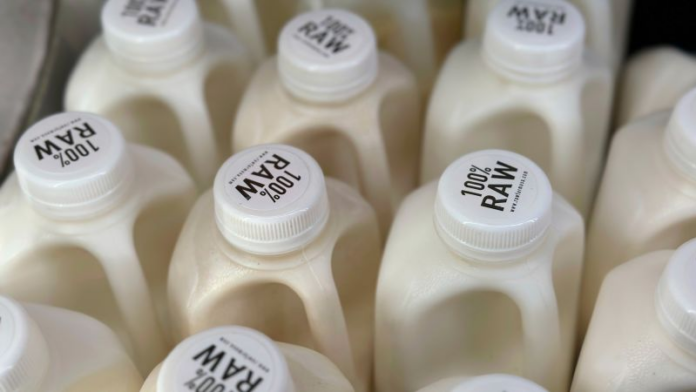CNN —
New lab experiments with milk from cows infected by H5N1 influenza, known as bird flu, confirm that it is infectious, especially when left raw, or untreated, and potentially even when flash pasteurized.
The researchers, from the University of Wisconsin School of Veterinary Medicine, are part of a federally funded program called the Centers of Excellence for Influenza Research and Response, or CEIRR. This network has been conducting rapid research to answer pressing questions in the H5N1 outbreak in dairy cattle.
In a research letter posted online on Friday in the New England Journal of Medicine, the researchers describe the results of experiments using milk from four infected cows — two from New Mexico and two from Kansas.
Because H5N1 virus is considered a select agent, it was handled in a high-security Biosafety Level 3 lab at the University of Wisconsin, using strict safety protocols.
First, they confirmed the raw milk was chock-full of H5N1 virus. Then, they stored some of the raw milk at refrigerator temperature to see if levels of the virus in milk would drop off over time. Over 5 weeks, viral levels in raw milk dropped a bit, but not much.
“That it wasn’t decaying over time is concerning,” said Dr. Seema Lakdawala, an associate professor of immunology and microbiology at Emory University who is also part of the CEIRR network but was not involved in the study.
In another series of tests, the researchers checked to see what types of pasteurization might work best for inactivating the virus.
They heated small samples of the milk at times and temperatures used in two types of pasteurization: low-temperature, long-time, or vat pasteurization; and high-temperature short-time, or flash pasteurization, which is the most common method used in the US today, according to the International Dairy Foods Association.
Heating the milk to 63 degrees Celsius, or 145 degrees Fahrenheit, for intervals between 5 and 30 minutes — the vat pasteurization method — reduced the virus to undetectable levels.
Heating the milk to 72 degrees Celsius, or 181 degrees Fahrenheit, for 15 or 20 seconds — conditions that approximated flash pasteurization — greatly reduced levels of the virus in the milk, but it didn’t inactivate it completely.
Milk samples heated for 15 or 20 seconds were still able to infect incubated chicken eggs, a test the US Food and Drug Administration has called the gold-standard for determining whether viruses remain infectious in milk.
“But, we emphasize that the conditions used in our laboratory study are not identical to the large-scale industrial treatment of raw milk,” senior study author Dr. Yoshihiro Kawaoka, a virologist who specializes in the study of flu and Ebola, said in an email.
That’s a good reason not to panic over the study findings, said Lakdawala.
Lakdawala said that commercial flash pasteurization involves a preheating step, which wasn’t done here. It also involves homogenization, a process that emulsifies the fat globules in milk so the cream won’t separate. Both of those steps would probably make it harder for the virus to survive, but she adds that the results of this study suggest full process of commercial flash pasteurization should be done “with all the steps in place.”
Recent tests of 297 dairy products purchased at retail stores by the FDA found traces of genetic material from the H5N1 virus in about 1 of 5 milk samples, and further testing confirmed the viral fragments were inert and couldn’t make anyone sick.
The US Centers for Disease Control and Prevention says the risk to the general public is low, but people should not eat or drink raw milk or products made from it.
To date, H5N1 influenza has been found in 58 dairy herds in nine states. Michigan has now surpassed Texas as the state with the greatest number of infected herds.
To test whether the raw milk could infect other animals, researchers also squirted some of the milk into the mouths of mice. The animals showed signs of illness the next day.
On day four, the mice hadn’t died of their infections, but they were euthanized so that researchers could see what parts of their bodies had become infected. Scientists found the virus all over their bodies, with high viral loads in the lungs and respiratory tract. They also found virus in the mammary glands of the mice, even though they weren’t producing milk at the time.
Taken together, their findings confirm that raw milk can infect susceptible animals, the researchers said — and that could also indicate a risk to humans.
In a recent news briefing, officials with the US Department of Agriculture said that to their knowledge, none of the raw milk from farms known to have H5N1 infections was being sold to consumers.
Get CNN Health’s weekly newsletter Sign up here to get The Results Are In with Dr. Sanjay Gupta every Tuesday from the CNN Health team.
Not all dairy farms are testing their cows, however, and some of the infected cows in the current outbreak have not shown any symptoms.
“Raw milk is unsafe at any speed, and the notion that you could protect yourself against H5 infection by consuming it is erroneous. There are there are much safer ways to protect oneself namely avoiding raw milk,” CDC Principal Deputy Director Dr. Nirav Shah said in a briefing.
Asked if the raw milk in the new experiments looked different than normal, Kawaoka said the researchers only got a small number of samples but some had more debris than milk from healthy cows. That would get filtered out prior to sale, he said. Some of the milk looked yellow-ish, but he points out that milk from healthy and infected cows would likely be mixed together in a big vat, making it look normal — and impossible to tell whether milk is safe to drink just by looking at it.



